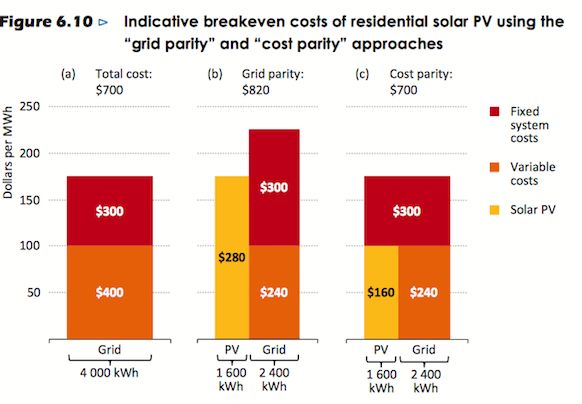The International Energy Agency has questioned the value of residential solar PV and accused it of becoming a “free rider” on networks that could lead to increased costs for other consumers, a move that is likely to upset the growing global solar PV industry.
In its World Energy Outlook 2013 report released overnight, the IEA says many parties suggest that the dramatic fall in the cost of solar PV in recent years means that it has -- or is fast becoming -- competitive with electricity generated from fossil fuels.
It says these arguments are based on the concept of “grid parity.” (Actually, it is probably more accurate to say they are based on “socket parity.”)
But, the IEA asks, is grid parity the right criterion by which to measure the full competitiveness of residential PV, based on the assumption that the industry can survive without the need for subsidies? The IEA says no -- at least not for those who remain connected to the grid.
The IEA sides with arguments put forward by utilities, in Australia and elsewhere that solar PV effectively allows households with rooftop installation to get a “free ride” on the grid by not making their fair share of contribution to grid costs. (This position shouldn’t be surprising, given the list of peer reviewers of the document -- it’s hard to find a renewable energy representative among them.)
From a system perspective, the IEA argues, the money invested in grids -- construction, maintenance, etc. -- needs to be recovered. And the group seems to indicate it should be. The IEA goes on to argue that when allowance is made for these variables, the cost of generation from solar PV systems would have to fall below grid parity to become competitive.
It gives the following example, illustrated in the graph below.

Source: IEA's World Energy Outlook 2013
Household A does not install solar PV, pays $300 per year in fixed charges (assuming all fixed costs are passed through), and another $400 per year for the 4 megawatt-hours it consumes, to give an average retail price of $175 per megawatt-hour.
Household B installs a solar PV system, which produces 1.6 megawatt-hours for consumption on site, for a total cost of $280 (equal to 1.6 megawatt-hours at $175 per megawatt-hour). It additionally purchases 2.4 megawatt-hours from the grid at a cost of $540 per year (which includes the fixed charges of $300 plus energy consumed). This, the IEA says to rousing applause from utilities, means that the solar PV household ends up paying more than Household A, despite installing solar and consuming less from the grid.
So, the IEA argues, the cost of the PV system would have to drop to $160 (1.6 megawatt-hours at $100 per), well below some current notions of grid parity, for it to make economic sense, as is illustrated in the case of Household C. The IEA contends that this is equal to the variable costs that the PV system is displacing.
The IEA further argues that any electricity exported back into the grid should get no more than the prevailing wholesale price; otherwise, it would “benefit from windfall profits.”
Because of this, the IEA says solar households could be benefiting from a “free-rider” effect, and suggests that a better measure would be “cost parity,” which includes the value of the grid. It even recommends differentiated tariffs to ensure that costs are recovered.
It is harder to imagine a more simplistic approach to the solar PV issue. The IEA's model takes no account of the potential deferral of grid expenditure, its impact on sidelining fossil fuel generation, and numerous other benefits, or even of the reality that grid operators have over-capitalized on their networks and should not be rewarded for their greed.
The solar industry will be howling in protest, and so should households. The irony is that the cost of solar is heading down below $100 per megawatt-hour anyway. It seems that this is more of a delaying tactic than a solution.
***
Editor's note: This article is reposted in its original form from RenewEconomy. Author credit goes to Giles Parkinson.



